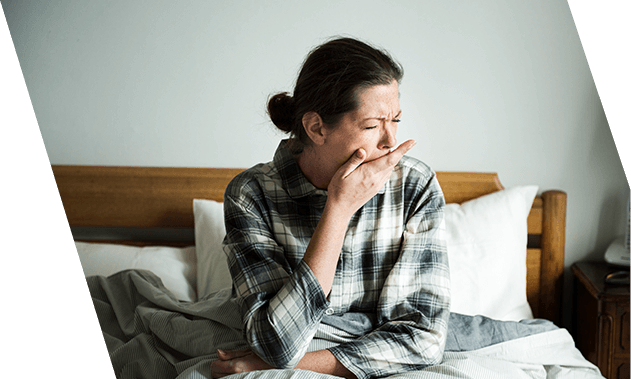Highlights
- Lunesta and Ambien are sedative-hypnotics that enhance the effects of the neurotransmitter GABA.
- Both medications help manage insomnia by promoting relaxation and can help to fall asleep and stay asleep.
- Both are prescription medications classified as Schedule IV controlled substances, indicating a lower abuse potential but still posing risks of dependency.
- Common side effects of both medications include drowsiness, dizziness, and headaches.
Different reasons can cause trouble falling asleep or staying asleep, including stress, too much caffeine or alcohol, intensive activity in the afternoons, or mental health conditions. If left unmanaged, over time, sleep problems can develop into insomnia, affecting the body and cognition. To prevent this, healthcare professionals typically offer psychotherapy or prescribe sleep medications, such as Lunesta and Ambien. Read on to learn the similarities and differences between these medicines.
What Is the Drug of Choice for Insomnia?
Lunesta and Ambien are among the most commonly prescribed medications for treating sleep disorders. They produce a calming effect and can help to manage insomnia symptoms in a short time. They are often prescribed in addition to psychotherapy and lifestyle changes. However, depending on individual symptoms, health history, and response to previous treatments, a healthcare provider can choose another medication for insomnia.
Are Lunesta and Ambien Controlled Substances?
Yes, Lunesta and Ambien are controlled substances. They are federally regulated by the
Specifically classified as Schedule IV, indicating a lower risk compared to Schedule II or Schedule III medications, Ambien and Lunesta still require careful monitoring and regulation. They are characterized by certain risks for dependency and the probability of being abused.
What Are the Main Differences Between Ambien and Lunesta?
Mechanism of Action
Since these medications belong to the same class, they have a similar mechanism of action. They act on gamma-aminobutyric acid (GABA), the central nervous system’s inhibitory neurotransmitter known to produce a relaxing and calming effect on the brain. By binding to GABA receptors, the medication enhances their effects and promotes relaxation, helping individuals fall asleep faster and stay asleep longer.
Although Lunesta works like Ambien, the key difference between the two is that Lunesta binds to a broader range of GABA receptors, which leads to a longer duration of action, allowing for longer sleep.
Lunesta Dosage Compared to Ambien
These medications differ in form and recommended dosages. The choice is based on the severity of insomnia and the patient’s response.
| Medication | Lunesta | Ambien |
Form | Tablets with doses of 1 mg, 2 mg, and 3 mg |
|
Common dosage instructions | The typical starting dose is 1 mg, taken once per night before bedtime, with a maximum of 3 mg if needed |
|
Note that the dosage and other instructions are determined individually. Follow your healthcare provider’s recommendations and do not alter your dosage without consulting a medical professional.
Side Effects
Both medications carry associated side effects, which vary in frequency and severity. The common mild side effects usually go away in some weeks. Serious ones need prompt medical attention and must be addressed by a qualified healthcare professional.
Common side effects of both medicines include:
- Drowsiness
- Dizziness
- Headaches
- Nausea
- Cold
- Diarrhea
- Abnormal dreams
The rare side effects are almost the same for both medications and are the following:
- Hallucinations
- Major depressive disorder
- Suicidal thoughts and behavior
- Confusion
- Memory loss
- Sleepwalking
- Drastic changes in the behavior, such as feeling detached, getting aggressive, etc.
If you experience any severe, prolonged, or otherwise uncomfortable side effects, consult your clinician. The typical solutions include dosage adjustment, stopping the medication, or switching to another medicine.
Interactions
Both Lunesta and Ambien can interact with other medications and substances, such as:
- Central nervous system (CNS) depressants
- Antifungal drugs
- Certain antibiotics
- Alcohol
It is important to inform your doctor of all other medications because interactions can influence the effectiveness and increase the risk of side effects.
Warnings
Patients taking Lunesta or Ambien must be aware of the following common warnings when starting treatment:
- Possible next-day drowsiness, dizziness, and decreased alertness.
- Complex sleep behaviors, such as sleepwalking, sleep-driving, and engaging in other activities while not fully awake, especially if there is a history of sleep disorders.
- The possibility of respiratory depression, particularly in individuals with underlying respiratory disorders or compromised lung function.
- An increased risk of suicidal thoughts and behaviors, particularly in individuals with a history of depression or other psychiatric disorders.
- Caution is needed during pregnancy and breastfeeding. A healthcare provider should weigh the risks and benefits of treatment.
- Prohibited for prolonged use or at higher-than-recommended dosages.
Abuse and Overdose Risks
As Schedule IV controlled substances, Lunesta and Ambien indicate
Ambien is known for a higher risk of abuse as compared to Lunesta due to its rapid onset and potential for producing euphoria. However, long-term use of both medications can lead to tolerance, where higher doses are required to achieve the same therapeutic effect.
Overdose can be life-threatening, especially when combined with alcohol or other CNS depressants, and requires immediate medical attention. Its symptoms may include:
- Severe drowsiness
- Confusion
- Respiratory depression
- Coma
Dependence and Withdrawal
Lunesta and Ambien carry a risk of physical dependence in the case of prolonged use. It means the body gets accustomed to the medication and requires increased amounts of it to function normally. This may also lead to withdrawal symptoms if the medication is abruptly stopped, including the following:
- Rebound insomnia
- Anxiety
- Irritability
- Agitation
- Tremors
- Sweating
- Nausea
- Vomiting
- Muscle and stomach cramps
- Seizures
To minimize the risk of withdrawal symptoms, it’s crucial to taper off Ambien or Lunesta under medical supervision. The process involves gradually reducing the dose over a period of time to help the body adjust to lower levels of the medication.
Lunesta vs Ambien: Effectiveness
Do You Need a Prescription for Lunesta or Ambien?
Yes, as both Lunesta and Ambien are prescription sleep aids, they require a prescription from a licensed healthcare provider for legal purchasing and usage. Also, controlled substances often have limits on the number of permitted refills, requiring additional evaluations or new prescriptions if continued use is necessary. Healthcare providers always assess the patient’s medical history and current medications before providing prescriptions for these medications.
Before Changing Medications
Before changing from Ambien to Lunesta or the other way around, it’s essential to consult with a healthcare provider for safety considerations. Your clinician will assess your medical history, discuss reasons for the change, and identify any risks such as drug interactions, side effects, or dependency concerns.
Doctors typically recommend a gradual transition from one medication to another to avoid withdrawal symptoms and other adverse effects. This process involves tapering off the old medication while slowly starting the new one. Regular follow-up with your healthcare provider is important to monitor your response during the change and make any necessary dosage adjustments.
Bottom Line
While there is a difference between Ambien and Lunesta in their formulation and particular adverse effects, both are considered to be potent insomnia medications. The choice between them should be made in consultation with a healthcare professional, considering symptoms, diagnosis, and other aspects of health history.
FAQs
Can Lunesta or Ambien be used in combination with other sleep aids or medications?
Using Lunesta or Ambien with other sleeping pills may be risky. It can lead to excessive sedation, daytime drowsiness, dizziness, impaired coordination, respiratory depression, and even life-threatening situations. It is important to always consult your healthcare provider before starting any new or additional medications to evaluate benefits and risks.
How do Lunesta and Ambien affect sleep architecture and sleep quality in the long term?
The long-term use of Lunesta and Ambien can alter sleep architecture, reducing REM sleep and leading to drug tolerance, dependence, and withdrawal symptoms. This can result in disrupted sleep patterns, rebound insomnia, and reduced sleep quality over time. It’s crucial to use these medications under medical guidance and not longer than prescribed.
Is Lunesta less habit-forming than Ambien?
Both medications are classified as Schedule IV controlled substances by the DEA and have habit-forming potential. There is no strong evidence indicating that Lunesta is less habit-forming than Ambien.
Are Lunesta and Ambien the same drugs?
Although they are both sedative hypnotics prescribed to treat insomnia, Lunesta contains eszopiclone and Ambien contains zolpidem. So, they have different chemical structures, side effects, duration of action, and dosing guidelines.
Is Lunesta or Ambien better for insomnia treatment?
The effects of Lunesta are longer than those of Ambien, but generally, the effectiveness of these medications is almost the same. Note that only a licensed healthcare professional can determine the most suitable medicine based on a detailed assessment.
Can Lunesta and Ambien be prescribed in pregnancy?
Using any of these medications to treat insomnia during pregnancy may not be completely safe. A healthcare provider will only prescribe any of them if the need for prescribing and expected benefits are significantly higher than potential risks.













